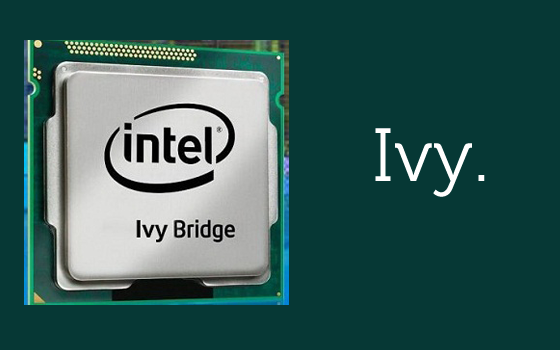With every year we see new technology popping up on the face of the earth, bringing with it the unavoidable need to update your gadgets. 2011 gave us Sandy Bridge CPUs, dual-core processor powered tablets, AMD’s Bulldozers, and much more. Let’s see what 2012 has in store for us.
Beyond the Sandy Bridge
Intel and AMD are the two major players in the Desktop and Laptop market, others seldom get a chance to show off their talent in the field. Last year, Intel broke ground with the amazing Sandy Bridge CPUs, which could have 8-cores, out of which up to 6 could be active at a time, and operate with 12 threads, providing a whopping 3.3GHz on a Core i7 Extreme processor. One would think it would be extremely difficult to top it off, however, the Ivy Bridge processors show even more promise, with even more speed, and backwards compatibility, which is a feature we have been missing for a long time!
The Ivy Bridge processors are expected to have the following improvements over their predecessors:
- Tri-gate transistor technology (less than 70% power consumption at the same performance level as 2-D planar transistors).
- PCI Express 3.0 support.
- Max CPU multiplier of 63 (57 for Sandy Bridge).
- RAM support up to 2800MT/s in 200MHz increments.
- Intel HD Graphics with DirectX 11, OpenGL 3.1, and OpenCL 1.1 support.
- The built-in GPU is believed to have up to 16 execution units (EUs), compared to Sandy Bridge’s maximum of 12.
- A new random number generator and the RdRand instruction, which is codenamed Bull Mountain.
- Intel Quick Sync Video.
- DDR3L low voltage for mobile processors.
- Multiple 4K video playback.
If you thought that speed was the USP of this processor microarchitecture, you were wrong. The best thing about these new processors is going to be their small size. The die will have 22nm nodes, which is one step ahead of the 32nm nodes of Sandy Bridge nodes The 22 nanometer (22 nm) node is the CMOS process step following 32 nm. It was introduced by semiconductor companies in 2011. The typical half-pitch (i.e., half the distance between identical features in an array) for a memory cell is around 22 nm.
An Ivy Bridge CPU will supply performance similar to that of a Sandy Bridge CPU while consuming less power and it will offer greater performance while consuming the same amount of power. That means you’ll see laptops that provide better battery life without sacrificing speed, as well as faster desktops that are easier on your utility budget, which means the hole in your pocket will be a bit smaller, than what it would have been in 2011. One thing’s for sure, good things do come in small packages.
You can expect these delightful packages by the end of April, if you are looking to buy.
Piledriving the Bulldozer
The budget-minded AMD was very late in delivering its new line of processors in 2011, which let down the AMD-fans as the whole world was enjoying the Sandy Bridge by then. And when they did showcase them, it was an unmitigated disaster. The best chip technology that AMD could muster failed to outdo Intel’s midrange offerings. The Bulldozer line could be outperformed by AMD’s own Phenom II X6, and even the Sandy Bridge Core i5.
The company will follow up the Bulldozer microarchitecture with Piledriver, an enhanced variant of the Bulldozer core. Actual details are slim, and code names for individual desktop and laptop lines abound, but we do know that AMD will be looking to boost the performance per watt and will be baking in stronger GPU cores. Piledriver is still expected to be a 32-nanometer architecture, which puts AMD at something of a disadvantage in light of Intel’s 22-nanometer Ivy Bridge.
Don’t expect to see Piledriver until sometime around the middle of 2012. Bulldozer arrived only a few months ago, after all.
More Cores for Mobile Devices
First your phone had the amazing FM Radio, then the MP3, then the video recording, then it suddenly evolved into a beast that could give you HD, Online Multiplayer games, and also a companion to talk to (Siri, anyone?). Now, it is going to give your PC a run for its money, when players like Qualcomm and Nvidia take it upon themselves to deliver Quad-Core smartphones (Galaxy S3?) and tablets (ASUS Transformer Prime! And possibly iPad 3). The details to these are yet to be known, but you can expect phones that will be as powerful as a netbook in a much smaller, though costlier package.
Nvidia’s Tegra 3 is one of the first quad-core mobile CPUs to come to market, and the latest in Nvidia’s Tegra system-on-a-chip line. The system consists of an ARM Cortex A9 CPU with an integrated 12-core GeForce GPU to power the graphics. Expect a deluge of Android tablets to use these chips, as device manufacturers pile on the features in a never-ending arms race.
Qualcomm will be introducing quad-core Snapdragon S4 chips in time for the 2012 holiday season. These chips will support tablets running Windows 8. The S4 will be built on the 28-nanometer process, down from the 45-nanometer process that Qualcomm used on the current-generation S3 chips. Expect improved performance and reduced power consumption.
To conclude, it’s going to be a heck of an year, for technology freaks like me.

Leave a Reply